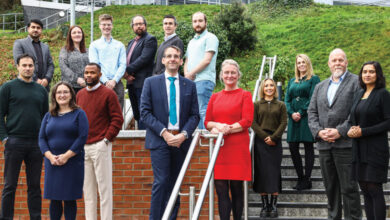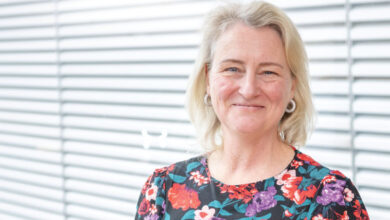Streamlined care
 Health care can be improved by taking paper out of the system, whether in records or referrals, according to Hugh Mullen.
Health care can be improved by taking paper out of the system, whether in records or referrals, according to Hugh Mullen.
As the Health and Social Care Board’s outgoing Director of Performance Management and Service Improvement, Mullen updated delegates on how ICT is modernising and transforming health services at an agendaNi seminar in April.
Health service management was a late adopter of ICT compared to other sectors, Mullen remarked, and the service was “still doing an awful lot with pieces of paper.”
The global banking sector spends 6.9 per cent of its budget in ICT while the global health spend in the same field is 3.9 per cent. Northern Ireland’s health and care spend is around 1 per cent of the overall budget, but the figure is growing.
In his view, ICT is “fundamental to high quality health and social care services.”
Major improvements have been made. Two years ago, more than 70 per cent of PCs in the sector were more than three years old and not capable of running modern software. He recalled visiting a community paediatrician who was based in a “shack” next door to a health centre with no computer.
Senior ICT staff emphasised the need to modernise and improve the basic ICT infrastructure, as there was little point in providing new services if this was not fit for purpose.
The Northern Ireland Picture Archiving and Communications System (NIPACS), which allows images to be stored and sent electronically between hospitals, was a key project. However, to one ICT professional, implementing it felt like building a penthouse on top of a wooden hut.
Since then, almost £30 million has been invested in infrastructure and software licences. This has included network upgrades to support NIPCS and 14,500 new PCs. Another 14,500 are needed as around 40,000 staff need a PC to do their job.
If modern desktop software is used properly, there would be no need for every manager to have a full-time secretary, he commented. Those staff could be redeployed elsewhere. In his unit, there are just four administration staff for 30 senior managers.
All GP practices now have broadband links to the Health Service network. Primary care infrastructure has historically been better than in secondary care. All major ICT systems are now linked to the health and care number index, which ensures that everyone in the province has a unique medical record.
The cancer patient tracking system (known as CAPPS) is an achievement of which he was particularly proud. If a specialist thinks that a patient has cancer, he or she must be treated within 62 days but this may require a referral to another hospital.
Before the system was introduced, doctors communicated by phone and on paper. Now, they can discuss a patient’s condition by video-link in real time, which also helps train junior doctors and nurses.
“Basically if you’ve got cancer, you just worry until you know what’s going to happen to you next. We’ve got to make sure that’s done in as timely a way as possible as well as obviously as clinically effectively as possible.”
NIPACS is now live in three trusts and will be rolled out regionally within six months. A comprehensive electronic care record has been piloted in two hospitals; this draws together information on the patient from all the relevant systems.
Going forward, the key priority is to improve the information system for community care and social work.
GP referral letters could also be replaced by electronic communications, thus ending the problem of lost letters and allowing messages to be tracked as they go through the service; the board hopes to use the SCI Gateway system.
“I do not worry about the confidentiality issue at all. It’s a red herring,” he said. Electronic systems can only be an improvement on paper records as anyone can walk into any UK hospital and walk out again with a medical record. The procurement system, he insisted, took far too long and takes up the time of three to four staff for several months.
“We have got to make sure that the front and centre of this is how do we improve patient care, how do we improve care to clients [and] how do we improve services to the public?”





